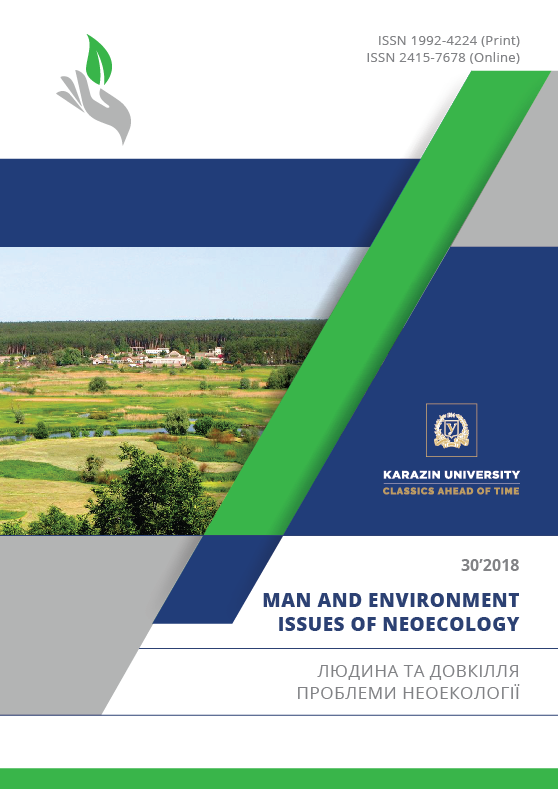Possible Changes of Bioclimatic Conditions of Winter Period in Ukraine
Abstract
Purpose. Assessment of bioclimatic conditions of cold season on the basis of weather severeness indices and analysis of their dynamics on the territory of Ukraine. Methods. Estimation of possible values of some cold stress indices and their changes in different regions of the country is based on two scenarios А1В and А2. Results. Possible consequences of climate change on human health in Ukraine are considered. On the base of Bodman index and wind chill factor of Siple-Passel, there are given forecast parameters of uncomfortable climate within three periods: 1986-2005, 2011-2030 and 2031-2050 years. According to both scenarios, mean values of Bodman index during the given periods on the major part of Ukraine reach to 2-3 points and this means that during certain winter months and whole winter moderate severe conditions will prevail, though in western and southern areas will dominate slightly severe ones. According to both scenarios, during December-January within first and second periods in some areas of the country even high risk of hypothermia is possible, as well as frostbite of open parts of the skin in 5-10 minutes can occur. The most severe conditions are expected in January-February in Sumy (A1B) and Lugansk (A2), the least severe – in Kropyvnytsky (A1B) and Ternopil (A2). The trend of hypothermia and frostbite conditions change during the winter season in different regions of the country has been analyzed. Conclusions. The trend of decrease of Bodman index prevails on the whole territory of the country during all winter months. Weather conditions in February are the harshest in first and third periods and weather conditions in January-February are the most severe in the second period (А1В), according to another scenario for the whole researched time the harshest conditions are observed in January. In all analyzed time periods, in December winter weather conditions were the most comfortable according to both scenarios. But mostly repeatability of wind chill factor of Siple-Passel prevailed in the interval of 0 ÷ -9 ºC, thus a slight risk of frostbite, some discomfort will be observed. So, in winter expected compounds of low air temperature and wind in certain days in future might cause frostbite of different levels, they will influence on spreading of infections epidemics and «cold» diseases.
Downloads
References
Tsifryi i faktyi. Prinyatie mer po zaschite zdorovya naseleniya Evropyi ot izmeneniy klimata [Figures and facts. Taking action of protection health population of Europe from climate change]. (2008). VOZ. Kopengagen Available at: http://www.fs_4_Apr_08r.pdf [in Russian].
Kosovets, O.O., Pahalyuk, O.E. (2009). Klіmatichnі ekstremumi v umovah zmіni klіmatu. [Climatic extremes in conditions of climate change]. Fіzichna geografіya ta geomorfologіya, (57), 81-89 [in Ukraine].
Kosovets, O.O., Pahalyuk, O.E. (2012). Oglyad temperaturnogo rezhimu ta opadіv u 2011 rotsі: Pіvnіchna pіvkulya, Evropa ta Ukraina. [Review of thermal regime and precipitation in 2011: Northern hemisphere, Europe and Ukraine]. Tsentralna geofіzichna observatorіya. Available at: http://www.cgo.kiev.ua/index.php?fn=klimat_2011&f=ukraine/data-u-klimat [in Ukraine].
Boksha, V.G., Bogutskiy, B.V. (1980). Meditsinskaya klimatologiya i klimatoterapiyaa. [Medikal climatology and climatotherapy]. Kiev: «Zdorov’ya», 260 [in Ukraine].
Isaev, A.A. (2001). Ekologicheskaya klimatologiya [Ecological climatology]. Moskva: Nauchnyiy mir, 458 [in Russian].
Vrublevska, O.O., Katerusha, G.P. (2005). Prikladna klіmatologіya [Applied climatology]. Dnіpropetrovsk: Ekonomіka, 131 [in Ukraine].
Belyaeva, V.A. (2016). Vliyanie meteofaktorov na chastotu povyisheniya arterialnogo davleniya. [Impact of meteofactors on frequency of arterial pressure]. Analiz riska zdorov’yu, (4), 17–22 Available at: http://oaji.net/articles/2017/3795-1484138706.pdf [in Russian].
Malitska, L. V. (2017). Diskomfort pogodnih umov zimovogo perіodu v Ukrayinі. [Uncomfortability of weather conditions of winter period in Ukraine]. Ukrai'ns'kiy gіdrometeorologіchniy zhurnal, (20), 26-36 [in Ukraine].
Solomon, S., D. Qin, M. Manning, Z. Chen, M. Marquis, K.B. Averyt, M.Tignor and H.L. Miller eds. (2007). IPCC, Summary for Policymakers. In: Climate Change 2007: The Physical Science Basis. Contribution of Working Group I to the Fourth Assessment Report of the Intergovernmental Panel on Climate Change. Cambridge University Press, Cambridge, United Kingdom and New York, NY, USA.
Available at: https://www.ipcc.ch/pdf/assessment-report/ar4/wg1/ar4-wg1-spm-ru.pdf [in English].
Stepanenko, S.M., Pol'ovyy, A.M. eds. (2015). Klimatychni zminy ta i'h vplyv na sfery ekonomikyUkrai'ny [Climatic changes and their influence on the spheres of economy of Ukraine]. Odesa: TES, 518 [in Ukraine].
Shipko, Yu.V., Shuvakin, E.V. (2014). Spetsializirovannyiy klimaticheskiy pokazatel otsenki bezopasnosti rabot na otkryitom vozduhe v zhyostkih holodnyih usloviyah. [Specialized climatic index of assessment of open air work safety in severe cold conditions]. Geliogeofizicheskie issledovaniya, ( 9), 161-165 [in Russian].
Groen, G. (2018). Wind chill equivalent temperature (WCET). Climatology and scenarios for Schiphol Airport. KNMI. Available at: http://www.knmi.nl/samenw/kbs/ doc/WCET-Schiphol.pdf [in English].
Authors reserve the right of attribution for the submitted manuscript, while transferring to the Journal the right to publish the article under the Creative Commons Attribution License 4.0 International (CC BY 4.0). This license allows free distribution of the published work under the condition of proper attribution of the original authors and the initial publication source (i.e. the Journal)
Authors have the right to enter into separate agreements for additional non-exclusive distribution of the work in the form it was published in the Journal (such as publishing the article on the institutional website or as a part of a monograph), provided the original publication in this Journal is properly referenced
The Journal allows and encourages online publication of the manuscripts (such as on personal web pages), even when such a manuscript is still under editorial consideration, since it allows for a productive scientific discussion and better citation dynamics (see The Effect of Open Access).





